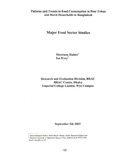| dc.identifier.citation | Halder, S. R., & Urey, I. (2003, September). Patterns and trends in food consumption in poor urban and rural households in Bangladesh: major food sector studies. Research Reports (2003): Economic Studies, Vol – XX, 122–242. | en_US |
| dc.description.abstract | This paper examines six major food sectors in Bangladesh namely rice, wheat, fishery,
poultry, dairy, and fruits and vegetables, concentrating on production and consumption
changes with evidence from the BRAC/Imperial household survey, together with insights
from focus group discussions. The nature of the marketing and processing chains are also
discussed together with key issues affecting the sectors.
The food sector study results indicate a growing divide between the consumption patterns of
the deficit group and the surplus group. The contrast is most marked between the rich and
poor living in urban areas and upazila centres. Those living in these areas are more market
dependent and vulnerable to price fluctuations.
The diet of the poor seems to be contracting in diversity, with rice increasingly dominating
consumption, though in urban areas there is some substitution with wheat based products for
convenience and possibly as a cheaper food source, as no fuel expense is entailed. All the
high protein items, especially animal products are beyond the means of the poor for
consumption on a regular basis, as demand from the growing urban population draws produce
into the market where the price is too high for the poor. For many, vegetables appear to be the
only remaining high protein food item. The urban poor appear to be the most vulnerable
without any access to home production.
For the surplus groups living close to centres and with good market access, dietary diversity
and the quality of produce consumed appear to be improving. Consumption of high protein
items is increasing as markets are facilitating greater availability in urban areas. Also
consumption of processed, packaged and branded items is becoming a regular feature of this
group, and there is evidence of a dispersion of this trend into more remote and less
rich/surplus areas. | en_US |

